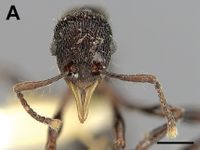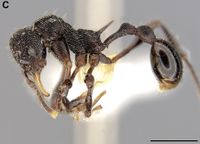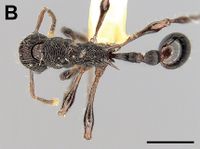Lenomyrmex hoelldobleri
| Lenomyrmex hoelldobleri | |
|---|---|

| |
| Scientific classification | |
| Kingdom: | Animalia |
| Phylum: | Arthropoda |
| Class: | Insecta |
| Order: | Hymenoptera |
| Family: | Formicidae |
| Subfamily: | Myrmicinae |
| Tribe: | Attini |
| Genus: | Lenomyrmex |
| Species: | L. hoelldobleri |
| Binomial name | |
| Lenomyrmex hoelldobleri Rabeling, Sosa-Calvo, O'Connell, Coloma & Fernández, 2016 | |
The single known specimen of Lenomyrmex hoelldobleri was recovered from a stomach content sample of the dendrobatid poison frog, Oophaga sylvatica.
Identification
Rabeling et al. (2016) - Lenomyrmex hoelldobleri can be distinguished from all other Lenomyrmex species by the following combination of character states: (i) petiolar node conspicuous, well-defined; (ii) a well-defined metanotal suture; (iii) conspicuous costae on its body; (iv) long erect hairs on the scape, and (v) size, being larger than all known species. Lenomyrmex costatus is morphologically most similar to L. hoelldobleri and both share the integumental sculpturing and the presence of long setae on the antennal scapes. However, L. hoelldobleri can be clearly distinguished from L. costatus by its well-defined petiolar node, the presence of the metanotal suture, its larger size, by having concentrically transverse striae on dorsum of propodeum (longitudinal in L. costatus), and the distinctly darker coloration.
Keys including this Species
Distribution
Latitudinal Distribution Pattern
Latitudinal Range: 0.912306° to 0.912306°.
| North Temperate |
North Subtropical |
Tropical | South Subtropical |
South Temperate |
- Source: AntMaps
Distribution based on Regional Taxon Lists
Neotropical Region: Ecuador (type locality).
Distribution based on AntMaps
Distribution based on AntWeb specimens
Check data from AntWeb
Countries Occupied
| Number of countries occupied by this species based on AntWiki Regional Taxon Lists. In general, fewer countries occupied indicates a narrower range, while more countries indicates a more widespread species. |

|
Estimated Abundance
| Relative abundance based on number of AntMaps records per species (this species within the purple bar). Fewer records (to the left) indicates a less abundant/encountered species while more records (to the right) indicates more abundant/encountered species. |

|
Habitat
Rabeling et al. (2016) - The habitat where the poison frog Oophaga sylvatica was collected was a secondary habitat with forest fragments and pastureland. The region encompasses remnant Evergreen Foothill Forests of the Western Cordillera (Ministerio del Ambiente del Ecuador 2012). This area is located in the Chocó Ecoregion, one of the most biologically diverse areas in the world with exceptionally high levels of endemism. The Chocó is one of the most threatened areas in the world (Brooks et al. 2002). The coastal northwest region of Ecuador, where the Alto Tambo area is found, is part of the wettest ecosystem known in Ecuador, with rainfalls ranging from 2000 up to 4000 mm annually (Ministerio del Ambiente del Ecuador 2012). Temperatures range from an annual average of 20 to 25° C (Ministerio del Ambiente del Ecuador 2012). The Foothill Forests are characterized by the dominance of tree species that can exceed 30 m in height. Trees are covered by orchids, bromeliads, ferns, and aroids. These forests have a dense herbaceous undergrowth layer dominated by Marantaceae, Araceae, and Polypodiopsida (Cerón et al. 1999). Two species of Lenomyrmex (Lenomyrmex foveolatus, L. hoelldobleri) occur in sympatry in the Alto Tambo area.
Biology
Castes
Nomenclature
The following information is derived from Barry Bolton's Online Catalogue of the Ants of the World.
- hoelldobleri. Lenomymex hoelldobleri Rabeling, C. et al., 2016: 83, fig 1 (w.) ECUADOR.
Unless otherwise noted the text for the remainder of this section is reported from the publication that includes the original description.
Description
Worker
Holotype. HL: 1.02; HW: 0.78; ML: 0.45; SL: 0.81; EL: 0.18; WL: 1.58; PL: 0.73; PW: 0.23; PPL: 0.46; PPW: 0.35; GL: 1.00; TL: 4.77; CI: 76; OI: 23; SI 79.
Holotype. Mandibles elongate, triangular with masticatory margin crenulated, 3 times longer than basal margin, sclerotized blunt peg-like denticles barely visible at 80x magnification. Clypeus without carinae, apical margin mostly convex and with a median angle; posterior margin convex, barely projects backward between frontal carinae. Frontal lobes inconspicuous, little expanded laterally, only partially covering antennal condyles. Antennal fossae large, deep, 1.5x longer than broad. Antennal scrobes absent. In full-face view, head with a broadly convex posterior cephalic margin; in full-face view, maximum width, just behind eyes, slightly narrowing posterad. Compound eyes large, protruding, with 15 facets along maximum diameter. Mesosomal profile with pronotum, mesonotum, and propodeum differentiated. Metanotal impression clearly marked. Propodeum armed with 2 long, acute spines, clearly longer than distance between their bases. In lateral view, inferior lobes of propodeum triangular. Femora claviform. Meso- and metatibiae lacking spurs. Tarsal claws simple, elongated. In lateral view, petiole long, fusiform, pedunculate; petiolar node well-defined; antero-ventral subpetiolar process directed forward, compressed in anterior-posterior direction, giving appearance of a spine in lateral view; anterolateral edges of process continue dorsally toward sides of petiolar peduncle. In lateral view, postpetiole dome-like, lacking a ventral process.
Mandibles smooth, slightly shining. Head, mesosoma, dorsum of petiolar node and postpetiole costate. The costae longitudinal in the head frons, concentric around eyes, predominantly transverse on pronotal dorsum, transverse on mesonotum, concentrically transverse on dorsum of propodeum, longitudinal on disc of petiole and postpetiole. Lateral margins of mesosoma with longitudinal costae, coxae with transverse costae, discrete in meso- and meta-coxae. Petiolar peduncle with granulations. Postpetiole mostly shining, and dorsolaterally with fine longitudinal striae and granulations ventrolaterally. Gaster smooth, shining except for dense punctures on pygidium and hypopygium.
Clypeal apical margin with several short, erect hairs. Head frons, leading edge of antennal scape, pronotum, node of petiole, disc of postpetiole, and gaster with scattered erect hairs, most of them longer than maximum diameter of eye. Erect hairs on dorsum of petiole and legs as long as, or shorter than, maximum eye diameter. Hairs on antennal scape longer than maximum diameter of antennal scape. Funicular antennal segment with numerous short decumbent hairs. Otherwise body devoid of hairs. Body black; legs and coxae lighter; antennal club, mandibles, and gastric apex yellowish-brown.
Type Material
Holotype worker. ECUADOR: Esmeraldas; 4 Km SW of Alto Tambo, next to Reserve Otokiki; elevation 676 meters above sea level; GPS coordinates: 0.912306, -78.583528; 09.vii.2013; from the stomach content of a male specimen (frog voucher number: CJ1689; SVL = 36.7 mm) of the Little Devil poison frog, Oophaga sylvatica; leg. L. A. O'Connell, E. E. Tapia, L. A. Coloma; unique ant specimen identifier: USNMENT01124322; deposited in National Museum of Natural History.
Etymology
This species is named in honor of our colleague and friend Bert Hölldobler on the occasion of his 80th birthday. Because of Bert's passion for ants, his pioneering and high-caliber contributions to entomology and behavioral ecology, as well as his dedication to mentoring the next generation of myrmecologists, myrmecology has become its own discipline in entomology, and continues to attract enthusiastic students who share Bert's love for ants.
References
- Cantone S. 2018. Winged Ants, The queen. Dichotomous key to genera of winged female ants in the World. The Wings of Ants: morphological and systematic relationships (self-published).
- Rabeling, C., Sosa-Calvo, J., O'Connell, L.A., Coloma, L.A. & Fernández, F. 2016. Lenomyrmex hoelldobleri: a new ant species discovered in the stomach of the dendrobatid poison frog, Oophaga sylvatica (Funkhouser). ZooKeys 618: 79–95 (doi: 10.3897/zookeys.618.9692).

